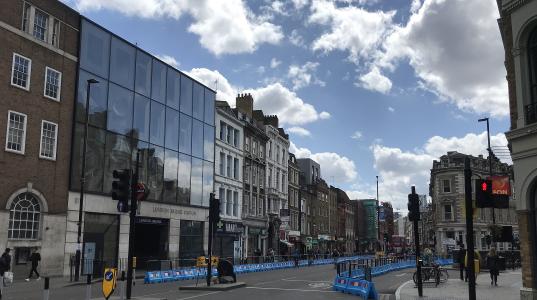
Air pollution differs across London. Not all areas have seen the same effects of lockdown measures, and in some parts of the city different sources contribute more pollution than others.
One of the benefits of a hyperlocal monitoring network – like Breathe London – is the ability to see the differences between locations, and get a clearer sense of how pollution changes at a local level.
In a new analysis of Breathe London data, we took a closer look at Borough High Street to get a better understanding of the activities that contribute to air pollution in this area. Our findings show that businesses will have a key role to play as the city emerges from lockdown.
Lockdown changes
As part of the Breathe London pollution monitoring project, we previously assessed the overall changes in harmful nitrogen dioxide (NO2) levels for the first four weeks of confinement measures. NO2 is a toxic pollutant produced when fossil fuels such as diesel, petrol or natural gas are burned that is harmful to our health if we breathe it in.
In support of environmental charity Global Action Plan and urban health foundation Guys & St Thomas’ Charity’s effort to Build Back Cleaner Air as COVID-19 restrictions are lifted, we have done a deeper dive on Borough High Street data as an example of a busy central area – frequented by Londoners and tourists alike. This is then compared both to the borough and London-wide data.
Looking at the Breathe London monitoring network’s average NO2 reductions in the first month of confinement, Borough High Street saw a 33% reduction in NO2 compared to an average of 9-17% across Greater London.
The location experienced elevated pollution before lockdown, and also has a different proportion of pollution sources in comparison to the average across Greater London and the borough, which we explore below. Additionally, the monitor is located near Borough Market on the south side of London Bridge, where essential works requiring traffic restrictions began 16th March (unrelated to lockdown). This likely impacted both the mix of vehicles and levels of traffic near the monitoring site.
Pollution from commercial activity
Our new analysis also examines modelled data on pollution sources, created by Cambridge Environmental Research Consultants, a partner in the Breathe London project. This dataset reflects typical 2019 concentrations of nitrogen oxides (NOx) generated by polluting activities at monitoring locations – i.e. the contribution of different sources during pre-lockdown conditions.
As we dove into this data at Borough High Street, a thriving commercial hub, we specifically wanted to know how relative activities – like heating, cooling and powering shops and offices, as well as delivery vehicles driving to and through the area – contributes to pollution levels locally. Although we can’t say what percent of the lockdown reductions came from specific sources, we know that commercial activities ground to a near halt during lockdown, so it can still be useful to examine how typical source contributions relate to the reductions observed in different areas.

We looked at how local concentrations from commercial activities at Borough High Street stack up against data from the wider area. The modelled data shows that, pre-lockdown, about a third of NOx pollution at monitoring sites across Greater London and Lambeth and Southwark – and nearly half (41%) at Borough High Street – was likely coming from commercial activity.
Businesses can take action
As a commercial hub, the Borough High Street location has a lot more of its pre-lockdown pollution coming from business-related activity than at most of the other monitoring sites across the city. This suggests there is greater potential to reduce pollution at the Borough High Street location through efforts targeted at businesses.
And even across Greater London, commercial activity makes up a big chunk of NOx pollution. The Build Back Cleaner Air project is offering businesses free support through the Business for Clean Air Initiative, which is the UK’s first free initiative to help businesses prioritise the most impactful ways to cut air pollution and make a green recovery post lockdown.
By looking closer at how air quality has changed since lockdown, as well as which activities are producing pollution, we can drive targeted solutions to clean the air. As the city reopens, businesses need to step up and reduce their own pollution emissions. It could go a long way toward creating a healthier London.
Breathe London will soon add more information on pollution sources to its map.